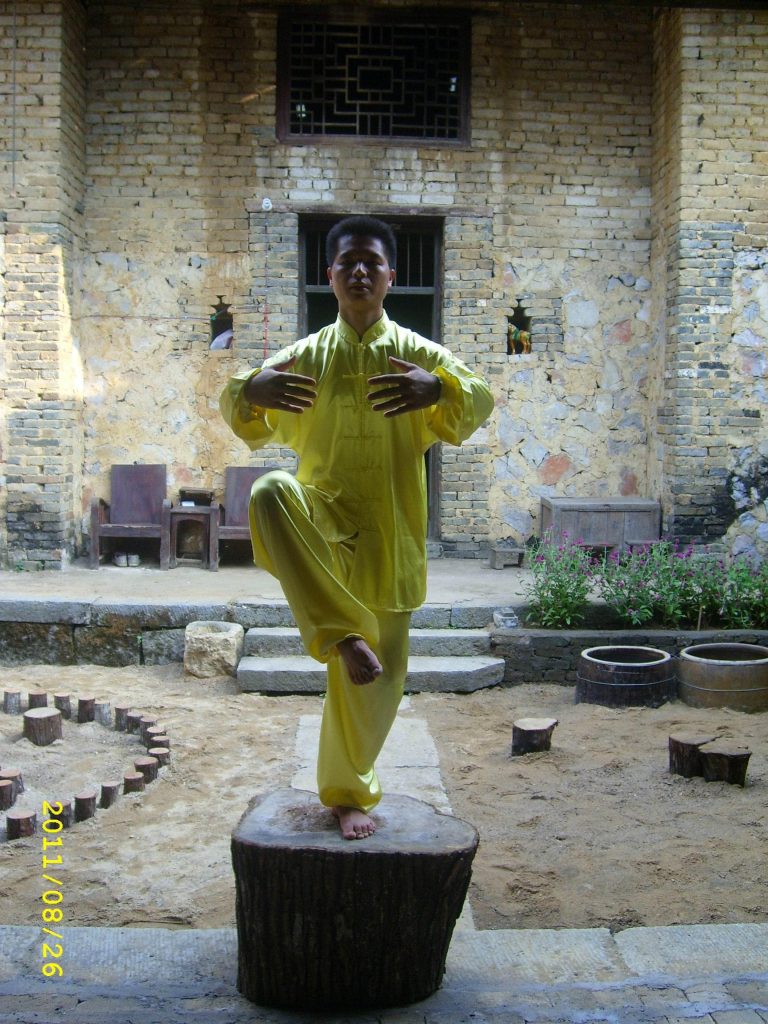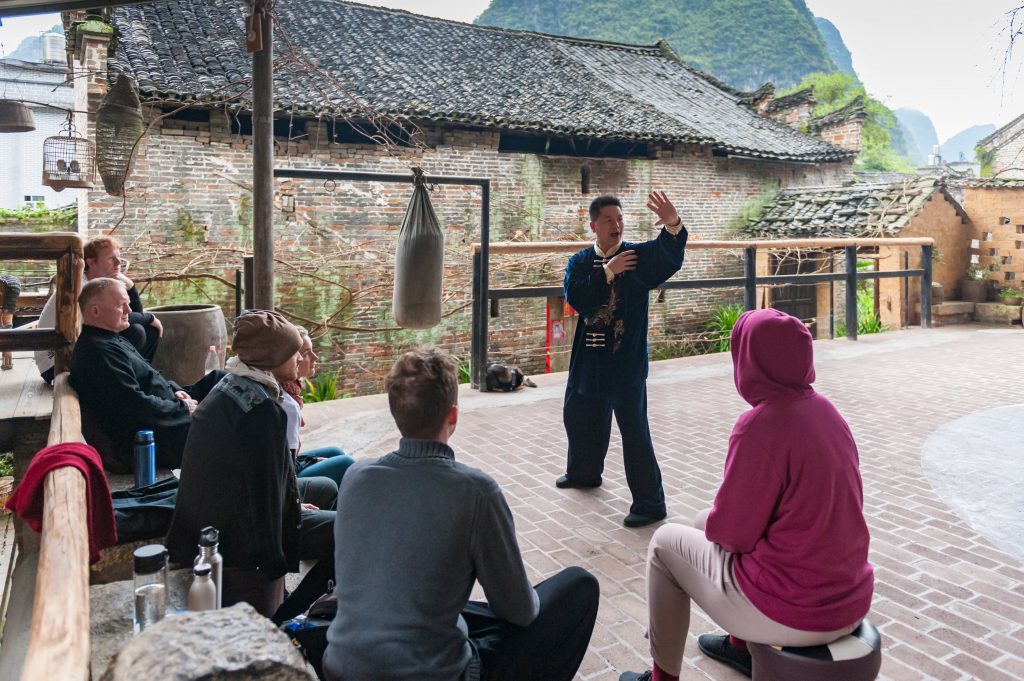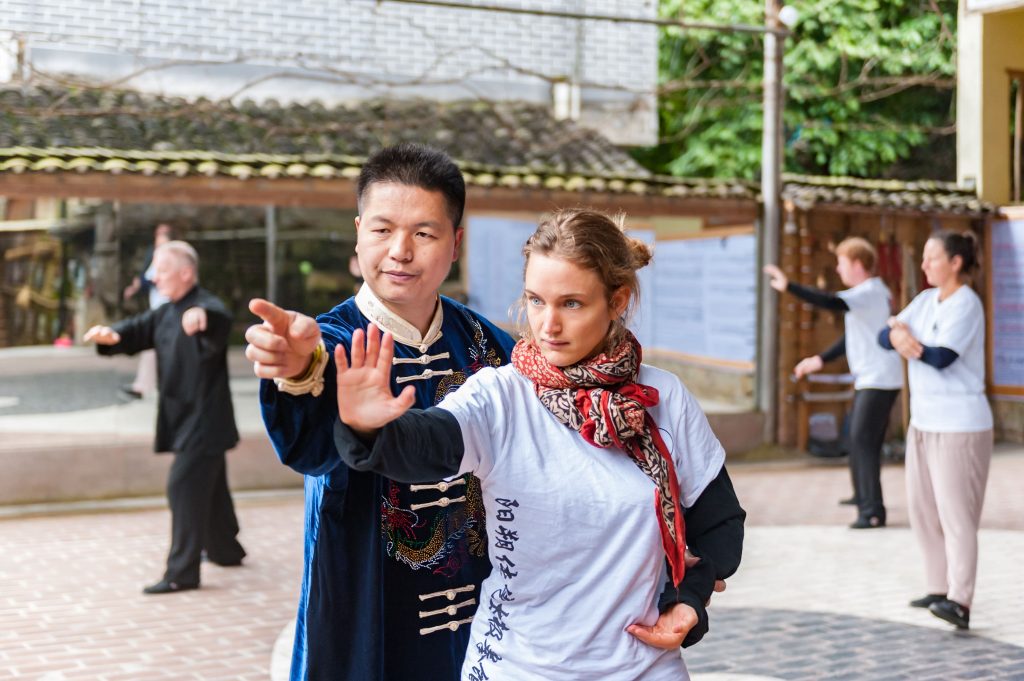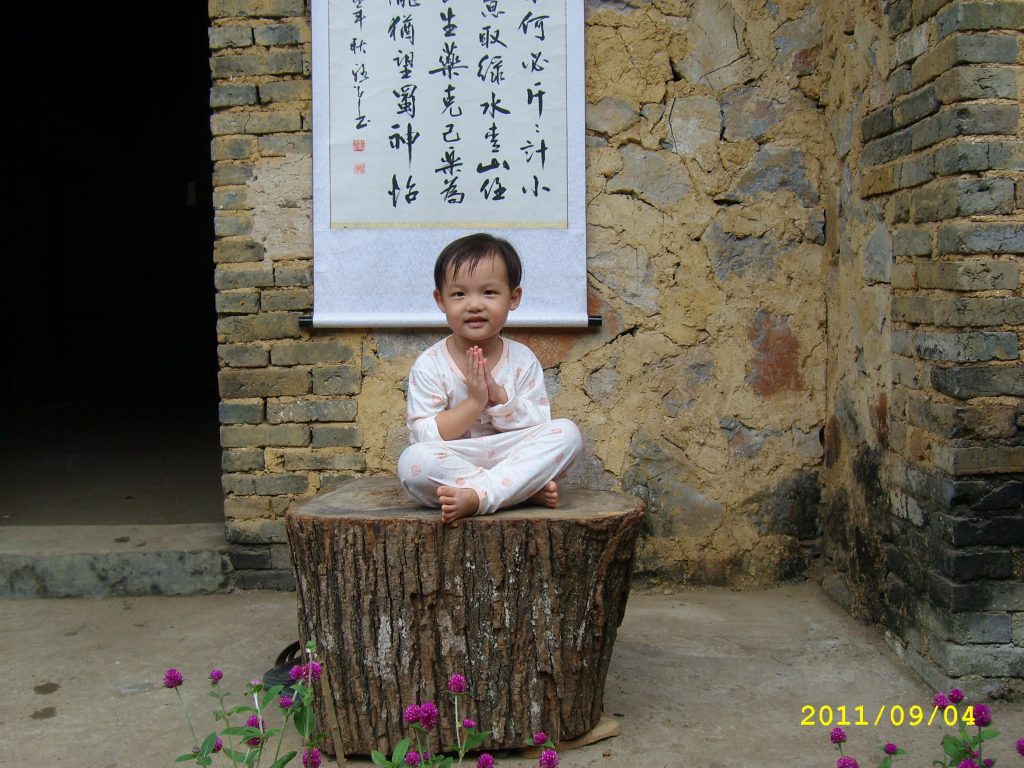The Practise of Tai Chi
1. In Tai Chi, tranquility means having a relaxed mind and is furthered by imagining that your body is merging into nature or your surroundings,becoming a part of the environment.
2. In Tai Chi, relaxation means that you are calm, relaxing your body by breathing. The pace and length of your breathing directly influences your body relaxation.
3. Sinking, normally used together with relaxing, is one of the special qualities that distinguishes Chen-style Tai Chi from the other styles of Tai Chi.It means that you allow your body, and Qi, to sink downwards into your feet.Chen-style requires the practitioners to focus their minds and their breath down to their Dantien which is a point about three inches below the navel.Advanced practitioners also then focus their mind and breathing down through the Dantien and then into the Bubbling Well, a meridian point in the middle of the foot. This takes some time to achieve and it requires patience. Even someone who has been practicing for six years may still have only a superficial understanding of intention in Tai Chi practice. Most of the movements in Tai Chi and Qigong are relatively simple, especiall yin Qigong. Even a beginner will gain the benefits of relaxation in their practice.However, to integrate breathing and movement together takes much more time. Your breathing pattern, including pace and depth, greatly influences your ability to relax. Correct Tai Chi breathing can regulate the nervous system, massage the internal organs, cultivate and regulate Qi and blood, promote a healthy metabolism and improve other functions as well. In Tai Chi practice, you use your mind and concentration to direct the Qi to circulate in your body. After consistent practice, you can feel Qi in your hand since the form of sensations of heat, numbness, tingling or an ache. This is a natural result of the increase of Qi and blood flow when body is relaxed. The “Reverse Abdominal Breathing” used in Tai Chi and Qigong is the opposite of the human body’s natural breathing. When inhaling, the lower abdomen is pulled inwards instead of naturally extending. Simultaneously the diaphragm rises and the Qi rises from the Dantien. As a result the chest naturally expands, increasing the lung capacity. When exhaling, the lower abdomen relaxes, the diaphragm drops, the Qi sinks into the Dantien and the stomach and chest return to the normal position. When a practitioner’s breathing has become deep, regular, slow and soft, they can begin practicing reverse abdominal breathing. Advanced practitioners who have mastered the basics of reverse abdominal breathing can then begin guiding Qi with their intention during their practice.The first stage of guiding Qi in this practice involves the Microcosmic Orbit, or small circle. When the practitioner inhales they also gently grip the ground with their toes, gently pull up their perineum and also slightly tip their pelvis so that their coccyx moves forward. Simultaneously, the practitioner visualizes Qi moving up the spine from the perineum to the top of the head.As the practitioner exhales they relax their toes and perineum, and allow their pelvis to relax so that their lower back straightens and their coccyx moves back a little. They simultaneously visualize the Qi moving from the top of their head down their front to their perineum. More advanced practitioners move onto practicing the Macrocosmic Orbit, or large circle, while they are reverse abdominal breathing. The process is the same as the Microcosmic Orbit, except that the circle of Qi being visualized is bigger. In the case of Macrocosmic breathing, the circle of Qi goes from the middle of the bottom of the feet up the legs, then up the spine to the top of the head during inhalation. Then during the exhalation the Qi is visualized as moving from the top of the head down the front of the torso, through the Dantien and then down the legs to the middle of the bottom of the feet.When practicing either the Microcosmic Orbit or the Macrocosmic Orbit, the tongue is always placed at the top of the mouth, touching the flesh just above the back of the teeth. The reason for this is that when we pull up the perineum and place the tongue on the flesh behind the top teeth, we connect two meridians to make a circle. This circle of Qi made by connecting these two meridian lines between the perineum and the top of the head is known as the Governing Vessel. Connecting these two meridian lines enables us toincrease our blood flow and to cultivate more Qi. Tai Chi and Qigong work with the principles of nature. Relaxation is the most important element of practice, at every stage.Tai Chi is a combination of philosophies, which includes the wisdom of meridian theory of Chinese medicine, Confucianism, Buddhism and the essence of the Taoism. It is a martial art created on the basis of Yin and Yang. Tai Chi cultivates sensitivity, relaxation, balance, rooting and speed, requiring intention rather than force. This is because when the mind is gently but clearly focused and the whole body is relaxed, our body parts can work together in unity. Then Qi flows smoothly, and the body is capable of great speed and strength. Power in Tai Chi is applied through softness in order to maintain speed,sensitivity and rooting. During striking, the body only tightens for a moment,during impact, before returning to a relaxed state. As the Tai Chi principle states, “Soft not weak, fast not stiff.” There are two main types of power in Tai Chi, soft power and strong power.Soft power can be applied quickly or slowly, but it is not applied through striking. Strong power is always applied with speed and striking, even if the two opponent’s bodies are already touching when the strong power is used.For example, you can strike with your shoulder to your opponent’s shoulder even when they are touching.Mechanical power in Chen-style Tai Chi is generated through a spiralling /rotating motion within the body. A high level practitioner will rotate their legs,pelvis, hips, spine and arms everytime they move.It is a flexible and elastic force, an explosive force produced by the spiral motion of internal energy and external strength.
Therefore, it appears soft in motion and powerful when it reaches its intended force. The Tai Chi Principle that all movement is formed by Intention is probably the least understood and most difficult principle to understand. Use intention/mind not force means keeping a quiet mind,focusing on breathing and reaching a still and silent mental state rather than learn movement without intention. Beginners find it easy to use rigid force. In this case, you have to relax, do not exert, try to feel that your body including the skin, the hair, the channels are breathing, extending or flowing Force comes from the coordination of Chi and exertion. Tai chi is circular,when a movement reaches its limit, the intention continues; when its intention stops, its form remains; when its form ends, its Chi/Qi moves on. During practice, when a movement stops, the exertion seems to break,however, the intention remains. Chi returns to DanTian, preparing for the next movement. When Chi comes back to Dan Tian, there is a swelling feeling,which connects with MingMen. When Chi is concentrated, stored and swelling in DanTian, movement can be quickly exerted. It seems that exertion breaks, yet Chi, under the instruction of intention, flows through the whole body,preparing for the next exertion at will. Follow the intention not Chi which may become a hindrance. Intention/mind ismore like inspiration, or put it this way: intention is an abstract will inspired and felt by heart. If intention is not felt or inspired by heart and it is felt with out the fullness of Chi, the exertion will become very mechanical and rigid. The mere pursuit of the feeling may also make a hindrance which blocks the intention or mind. In all, the principle of intention is a too abstract an idea to be understood and mastered. Moreover, there are different requirements for intention at different levels, which can be divided as follow: In the initial stage, the practitioner’s intention is mainly to remove the distractions by practicing Wu Ji meditation and simple basic movements,thinking, remembering the key movement, the structure of the Tao Lu (aseries of skills and tricks in Martial Arts), the execution of the form and so on.Teachers should be good at guiding students, from the simple to the deep,from the easy to the difficult. At this stage the instructor should avoid introducing any abstract concept such as “keep intention to Dantian” “use intention not force” and so on. It is difficult for the students to understand and accept these ideas, and they are easy to be misunderstood. In the second stage when the practitioners are familiar with Tao Lu (a series of skills and tricks in Martial Arts) after a period of practice and their movements are becoming more standard, they will feel in their hands sensations of numbness, heat, swelling, which means there is an awareness of developing the inner energy or Qi. At this point, the instructor can teach the concept of intention. Students will have a rough feeling about what intention is, and they can feel it in their hands. They should be instructed to keep the feeling, relax and coordinate their body so as the internal energy of Chi fill sand flows around the body The third stage comes after a long period of exercise. In this phase,practitioners feel that the internal energy of Qi fills into DanTian at the end ofeach movement, which is done by the power of the mind. When Qi fills DanTian, practitioners feel heavy and full at DanTian In the fourth stage, practitioners can use intention to lead the energy of Qi to their feet and then to the tips of toes. To this extent, practitioners feel flexible in movements, steady as a mountain when staying in stances. As intention moves smoothly and breathing is coordinated, energy of Qi can be felt flowing all around the body. Tai Chi is the transformation and change of Yin and Yang in the various forms such as Emptiness or Fullness, Opening or Closing, Fast or Slow,dynamic or still, soft or firm. They describe the various aspects of Tai Chi. For example, Emptiness and fullness represents the nature of Tai Chi, opening and closing represents the function of Tai Chi, dynamics represents the state of tai chi, fast and slow represents the rhythm of tai chi, reverse and obverse represent the direction of tai chi, softness and firmness represents the strain of Tai Chi. The overall generalization is: the whole body relaxed, experience the overall loose, moving the center of gravity and turning waist, master the entanglement of strength, the combination of the intention, Qi and breathing. Staring for long periods harms the blood; lying down too much hinders the internal energy of Qi; Sitting too long hurts the muscle; standing too long harms the bones; walking too much impairs the sinews. References for internal use only









